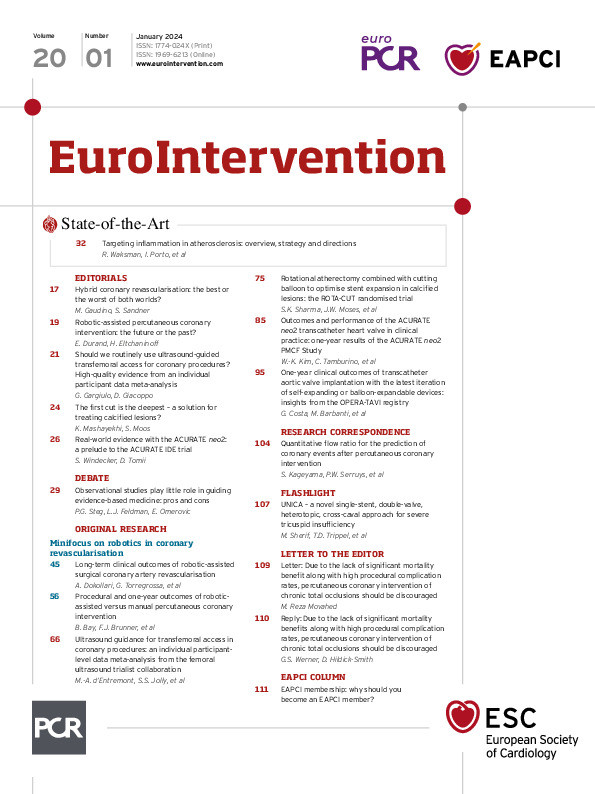Our interventional community has a burning question about which is the right plaque modification tool to treat calcified lesions. We frequently see patients with severely calcified lesions knowing that they have higher clinical event rates after percutaneous coronary intervention. Quite the dilemma. What is the optimal strategy in this challenging scenario? The answer to this question is still under intensive research.
Currently, two different atherectomy technologies are available: rotational and orbital atherectomy. While both were initially used frequently as bailouts for uncrossable lesions, atherectomy is now increasingly the first choice for debulking. Although a reduction of hard clinical endpoints has never been shown, both techniques are indispensable in our daily routine, and the believers are eagerly awaiting the results of the randomised ECLIPSE trial (ClinicalTrials.gov: NCT03108456) comparing orbital atherectomy with balloon angioplasty. The primary clinical endpoint of target vessel failure in 2,000 patients and their results are expected to be shared in late 2024. In addition to atherectomy, modified balloons, such as cutting and scoring balloons, are increasingly used in combination with conventional non-compliant balloons. Intracoronary lithotripsy is gaining ground due to its exceptional efficacy and safety as well.
Despite these efforts, the studies done so far have not shown any breakthrough benefit, regardless of the device, or combination of devices, used (Table 1)123456. The only exception showing a potential benefit of cutting balloons (CB) after rotational atherectomy (RA) was the PREPARE-CALC-COMBO study3, with a higher in-stent acute lumen gain and larger minimal stent area. Nevertheless, its major limitation was the single-arm prospective design.
In this issue of EuroIntervention, Sharma et al6 present the outcomes of the randomised ROTA-CUT trial addressing the unanswered question of whether a comparison of CBs versus non-compliant balloons after RA could optimise stent expansion5. The authors deserve praise for conducting the first randomised controlled trial providing information on the efficacy of cutting- or non-compliant balloon angioplasty directly after RA. The primary endpoint was the impact on the minimum stent area assessed by intravascular ultrasound. Although both strategies seem to be safe, no difference was seen for the intravascular imaging endpoint.
How can we explain this result? And, how does it affect our clinical practice? It is important to understand that the sample size of this study was very small, and no formal sample size calculation was possible, which may have led to a potential type 2 error by underestimating the effect of the CB after RA. Another potential confounder might be the presentation of calcium in different histopathological manners. Based on improved intravascular imaging modalities, our community learned a lot about different types of calcium patterns. Calcium may present as superficial (e.g., a calcified nodule) or as deep calcification, and its distribution can be concentric or eccentric. Each morphology requires different treatments; these include atherectomy, intravascular lithotripsy, super high-pressure angioplasty, scoring or CB, or a combination of multiple tools. In line with such variety of treatments, calcium patterns and the small sample sizes, no relevant differences were found in the above trials (Table 1).
For now, a clinical consensus statement has been recently published by EAPCI in collaboration with the EURO4C-PCR group7. This document provides a clear algorithm, based on intravascular imaging, for treating specific subtypes of calcified lesions, which allows a more differentiated approach.
Table 1. Studies for treating calcified coronary artery disease by percutaneous intervention including rotational atherectomy.
| Title | Date of publication | Study design | Number of patients | Intervention / control | Primary endpoints | Result |
|---|---|---|---|---|---|---|
| ROTAXUS 1 | 2013 | RCT | 240 | DES after RA vs DES without RA | In-stent LLL | RA did not reduce LLL of DES |
| PREPARE-CALC 2 | 2018 | RCT | 200 | DES after RA vs DES after MB | Strategy success, | Success more common after RA, non-inferiority of RA for in-stent LLL |
| in-stent LLL | ||||||
| PREPARE-CALC-COMBO 3 | 2022 | Single-arm, prospective | 110 | DES after RA+CBA compared with PREPARE-CALC cohort (DES after RA; DES after MB) | In-stent ALG on QCA, stent expansion on OCT | Higher in-stent ALG and higher MSA after RA+CBA |
| ROTA-Shock-Registry 4 | 2023 | Single-arm, prospective, observational | 160 | DES after IVL following RA | Final diameter stenosis <30% by QCA | High success rate, IVL after RA is effective and safe |
| ROTA.shock 5 | 2023 | RCT | 70 | DES after IVL vs DES after RA | MSA on OCT | MSA after IVL similar to RA |
| ROTA-CUT 6 | 2023 | RCT | 60 | DES after RA+CBA vs DES after RA+NCBA | MSA on IVUS | MSA after RA+CBA similar to RA+NCBA |
| ALG: acute lumen gain; CBA: cutting balloon angioplasty; DES: drug-eluting stent; IVL: intravascular lithotripsy; IVUS: intravascular ultrasound; LLL: late lumen loss; MB: modified balloon; MSA: minimum stent area; NCBA: non-compliant balloon angioplasty; OCT: optical coherence tomography; QCA: quantitative coronary analysis; RA: rotational atherectomy; RCT: randomised controlled trial | ||||||
Conflict of interest statement
The authors have no conflicts of interest to declare.

